Journal of Tourism & Hospitality
Open Access
ISSN: 2167-0269
+44 1300 500008
ISSN: 2167-0269
+44 1300 500008
Review Article - (2024)Volume 13, Issue 1
From the perspective of Feng Shui culture, this study examines six hotels in Hong Kong and Bangkok. By observing the design, decoration, and environmental layout of these hotels, as well as interviewing hotel staff on-site, the study explores the cultural values embodied in Asian hotel culture. Through a three-tier coding system, the research identifies the cultural values of Asian hotels as respecting the natural environment, valuing traditional culture, emphasizing harmony and balance, respecting guest needs, and considering destiny. These findings provide a basis for a better understanding of customer needs in the hotel industry and for improving their hospitality culture. They also offer valuable insights for future hotel design and management practices.
Traditional culture; Natural environment; Customer need; Hotel industry; Hospitality
In the fast paced era of rapid development, the Asian hotel industry has formed its own paradigm due to its unique culture, social values, and traditional beliefs. The cultural values of Asian hotels play a significant guiding role in shaping the customer culture, hotel style, design, and service. This study aims to explore the unique cultural representation of Feng Shui and its impact on the external style of Asian hotels. Six hotels in Hong Kong and Bangkok were selected as the research objects. By employing observation methods, the study analyzes the elements and details of Feng Shui's "harmony between heaven and humanity" perspective in the hotel's design, decoration, and environmental layout. The goal is to identify the cultural values that provide guests with a sense of home and a positive experience through hotel design. In summary, this study seeks to identify the specific manifestation of Feng Shui in the external style of Asian hotels, analyze its influence on hotel design, and explore the intrinsic connection between Feng Shui and the cultural values of Asian hotels [1].
Approaching from the perspective of Feng Shui culture, this study explores the cultural values of Asian hotels, revealing their essence and characteristics. This has important theoretical implications for studying the relationship between culture and the hotel industry. Firstly, this study expands the scope of hotel culture research, moving beyond the influence of Western culture and delving into the impact of Asian culture on hotel culture. Secondly, by examining hotel culture from the perspective of Feng Shui culture, this study explores the deeper meanings and cultural backgrounds, providing a unique viewpoint and approach that offer new perspectives for hotel culture research [2-4].
Furthermore, this study uncovers the characteristics and values of Asian hotel culture, which hold significant practical implications for the hotel industry. Firstly, a deep understanding of the cultural values of Asian hotel culture can enhance the understanding of Asian guests' needs and cultural backgrounds, thereby better meeting their expectations and improving service quality and customer satisfaction. Secondly, this study provides insights for hotel design and management by incorporating Asian cultural elements, enhancing the cultural uniqueness and brand value of hotels. Lastly, this research offers valuable insights for the sustainable development of the hotel industry, such as emphasizing environmental protection in hotel architecture design and promoting harmonious coexistence [5].
Feng Shui culture and its values: A total of 942 literature sources were found on CNKI using "Feng Shui culture" as the keyword. Based on the subject classification, the majority of these sources were concentrated in the fields of architectural science and engineering (33.92%), religion (18.06%), tourism (14.38%), and culture (7.74%). Further refinement by selecting "academic journals" as the criteria revealed 55 articles classified under tourism and 55 articles under culture. Among the tourism related articles, 7 focused on Feng Shui culture as the main theme, while 7 articles explored Feng Shui culture in relation to Langzhong ancient city and 4 articles examined Yang Xianling, along with other literature focusing on scenic areas such as Zhuge Bagua village in Lanxi, Zhejiang province. In the field of culture, Li Qike and Cao Xingsui conducted a comparative study on Feng Shui culture in China, Japan, and South Korea, and Liao Yang discussed the Feng Shui culture of the Han ethnic group in Hong Kong, Macau, and Taiwan [6]. Numerous scholars have focused their research on the Feng Shui culture of specific cities and villages.
According to the definition in "Cihai", Feng Shui, also known as "Kanyu," refers to the situation of wind direction and water flow around residential sites or burial grounds, which can bring fortune or misfortune to the occupants or the family [7].
Feng Shui study is a comprehensive environmental science that combines physics, psychology, hydrogeology, environmental ecology, meteorology, and other disciplines. Feng Shui culture is an ancient "architectural planning and design theory" that can guide the contemporary tourism industry. After centuries of development, the emphasis on Feng Shui principles and taboos has become an important part of everyday life for Chinese society, and Feng Shui has become a form of "collective unconsciousness" [8]. Since the 17th century, Feng Shui culture has spread worldwide, and foreign scholars have also conducted research and application on Feng Shui, recognizing that Chinese Feng Shui is a comprehensive natural science with significant landscape scientific value [9].
Kang Yu stated that Feng Shui is a concept established by ancient Chinese sages to adapt to and coordinate the development between humans and nature. The core concept in Feng Shui theory is "qi," which refers to vital energy, and the goal is to protect the "qi" of the environment from depletion. The core principle is to construct a harmonious living environment for humans and the environment based on the laws of nature. Feng Shui describes a relatively harmonious spatial environment where people can live and work comfortably. Fan Yinghua believes that Feng Shui culture combines modern ecology and environmental science to protect the environment and create a livable environment for humanity [10]. Lin Yutang regards Feng Shui culture as having aesthetic significance. Observations of astronomical phenomena, natural phenomena, and human behavior are the basis of fundamental Feng Shui knowledge. These observations, combined with astronomy, geography, and philosophy, form the theories of Feng Shui. Feng Shui theories mainly include yin and yang, the five elements, the eight trigrams, and the book of changes (Yijing) [11].
The concept of yin and yang runs through Feng Shui culture and describes the evolutionary process from Wuji (ultimateless) to Taiji (the supreme ultimate), Liangyi (duality), Sizhang (four phenomena), and the myriad things in the world. The five elements generate and control each other, representing the basic laws of motion and interaction between matters. The five elements are also related to shapes, such as circles representing metal, curves representing water, straight lines representing wood, diagonals representing fire, and squares representing earth. The five elements are also related to materials, colors, and numbers. The book of changes is the basic philosophical foundation of Feng Shui [12]. Also known as the Yijing or Zhouyi, it is regarded as the foremost of the confucian classics. It was first applied to the heavenly path and then combined with the earthly and human paths, forming a unity and integration of heaven, earth, and humanity. The bagua (eight trigrams) is the visual representation of the ideas in the book of changes [13].
The bagua can be divided into the pre-heaven bagua and the post-heaven bagua. The combination of the two forms a design language for spatial layout. The pre-heaven bagua, also known as the Fu Xi bagua, consists of four yang and four yin lines corresponding to heaven, earth, thunder, wood, water, fire, mountain, and marsh, presenting a three-dimensional state in the natural environment. The post-heaven bagua, also known as the wen wang bagua, consists of eight lines corresponding to the North, Southwest, East, Southeast, Northwest, West, Northeast, and South, presenting a two-dimensional state. The cosmic spatial concepts of the bagua can be applied to regional division and functional positioning, achieving a well-organized combination of multidimensional spatial environments [14].
This study primarily utilizes the method of observation for data collection and analysis. In research methodology, the observation method is a means of gathering data by observing and documenting phenomena. It can be employed to investigate the underlying meanings of various phenomena, including human behavior, social phenomena, and natural phenomena. It holds significant importance for understanding human society and culture. As the core of this study revolves around exploring the values reflected in the design of Asian hotels, the observation method is deemed suitable for conducting this research [15].
After determining the research questions, the researchers visited a total of six hotels for on-site observations and data collection. These hotels include the hotel icon in Hong Kong, Rosewood hotel in Hong Kong, Banyan tree hotel in Bangkok, Sukhothai hotel in Bangkok, Rosewood hotel in Bangkok, and Mandarin oriental hotel in Bangkok. The researchers took photographs and recorded the observed data during the visits. Finally, the research team analyzed the 279 captured photos and conducted data analysis. Through the analysis and interpretation of the images, they aimed to reveal the cultural significance and values reflected in the Asian hotel designs. Therefore, this study employed the observational method, which not only helps uncover the intrinsic and extrinsic aspects of Asian hotel designs but also provides valuable insights and references for the development and dissemination of Asian hotel paradigms [16].
Data processing
Open coding: The research team started by selecting, organizing, and categorizing the 279 photos. They used open coding to determine the photo categories, based on the following criteria:
Location: According to Feng Shui culture, the location of a hotel should avoid unfavorable terrains and instead choose flat and open areas. Additionally, the convenience of transportation and the avoidance of unfavorable surroundings should be considered, opting for places with beautiful environments and pleasant scenery [17]. A superior location helps attract positive energy (auspicious qi). For example, the Banyan tree hotel in Bangkok, as the first urban resort hotel is surrounded by the Chao Phraya river and the Royal park. "Embracing mountains and encircling waters" is an important principle in traditional Feng Shui. The concept of "water embrace" resembles the welcoming gesture of a person's outstretched arms, symbolizing hospitality and a favorable ambiance (Figure 1).
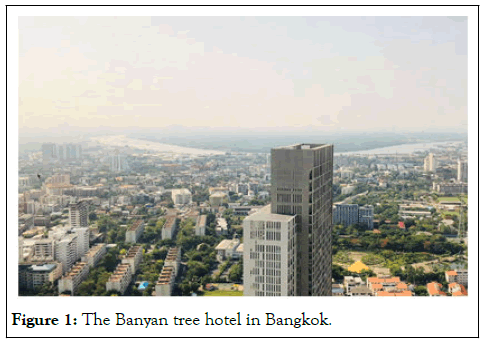
Figure 1: The Banyan tree hotel in Bangkok.
Architectural design: In addition to having a square shape, Feng Shui culture also values the beauty of "subtlety and elegance." For example, the hotels feature multiple spiral staircases, combining to create rich variations and achieving a profound artistic effect [18]. Another example is the architectural design of the Rosewood hotel in Bangkok, which resembles "two hands clasped together in prayer." In Thailand, influenced by Buddhist culture, people are not accustomed to shaking hands but instead greet each other with a prayer-like gesture. In Buddhism, clasping hands together symbolizes goodwill, peace, unity, the aspiration for harmony, and the recognition of the inseparability of all phenomena (Figure 2).
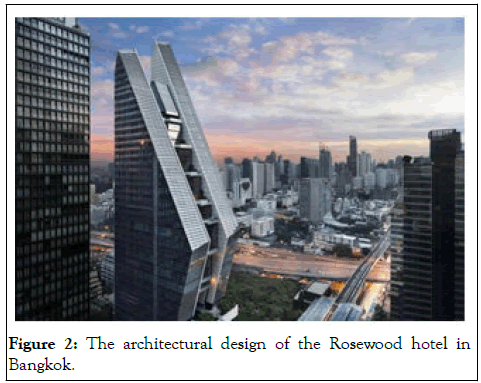
Figure 2: The architectural design of the Rosewood hotel in Bangkok.
Entrance: According to Feng Shui beliefs, the location of the entrance can influence the overall energy flow of a space. In hotels, the entrance should be designed in an area associated with auspicious symbols or dragons, or next to auspicious numbers such as "8" or "9". This is believed to enhance the hotel's attractiveness and fortune. The entrance of the hotel Icon in Hong Kong has two doors, and the door on the right side, when looking from the inside out, is usually kept open. This arrangement, combined with the strategic positioning of flower beds, completely avoids a direct alignment between the hotel and the road in front. The staircase leading to the lobby is positioned facing the check-in counter rather than the entrance door, avoiding a clash between the door and the flow of energy (Figure 3) [19].
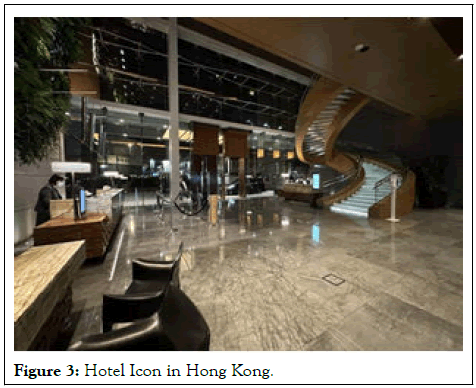
Figure 3: Hotel Icon in Hong Kong.
Environmental arrangement: At the B1 floor of the Banyan tree hotel in Bangkok, there is an arrangement of green plants, artificial mountains, and water curtains surrounding the restaurant. This setup reflects the harmonious beauty between humans and nature. The lighting ceremony adds a warm touch to the guest experience. From the perspective of the five elements in Feng Shui, the interplay between fire and water represents the concept of mutual generation and restraint. This kind of arrangement is commonly seen in Asian hotel architecture and design, and it symbolizes the balance and harmony between different elements (Figure 4) [20].
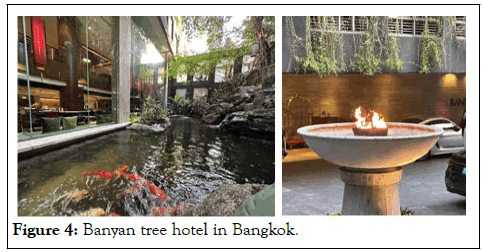
Figure 4: Banyan tree hotel in Bangkok.
At the Sukhothai hotel Bangkok, water elements are prominently featured. The hotel incorporates locally grown aquatic plants and uses sculptures that reflect the local religious culture as decorations. Additionally, glass walls are often utilized in public spaces such as the multipurpose halls. The hotel staff explains that this design helps to ward off negative energy and promote a favorable atmosphere (Figure 5) [21].
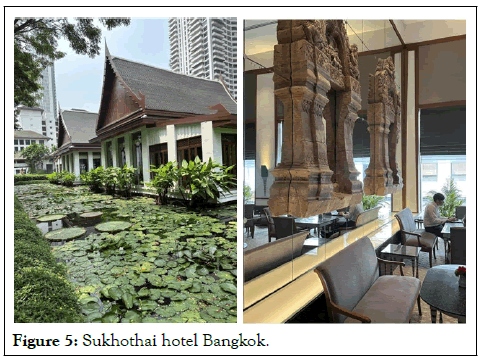
Figure 5: Sukhothai hotel Bangkok.
Space layout: According to Feng Shui principles, the interior space should be well-planned, flowing, and comfortable. Therefore, hotel designs take into consideration the arrangement of entrances, walkways, and sightlines for guests. Additionally, the use of flowers, fish tanks, and bonsai arrangements inside the hotel enhances the energy field and aesthetic appeal. Following the principles of the five elements, there is a balance between the generation and inhibition of elements, such as water countering fire and wood promoting earth [22].
In the lobbies of the Rosewood hotels in Hong Kong and Thailand, the main entrance features a revolving door. The design of the revolving door allows for the circulation of energy while preventing financial luck from flowing out. The lobbies are decorated with marble floors, high ceilings, pearl curtains, champagne gold accents, and wooden embellishments, creating a smooth energy flow and incorporating the elements of Feng Shui. These design elements symbolize prosperity and growth, creating spacious and bright environments that retain positive energy (Figures 6 and 7) [23].
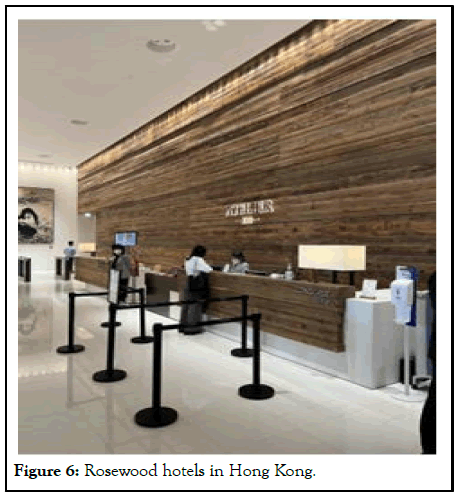
Figure 6: Rosewood hotels in Hong Kong.
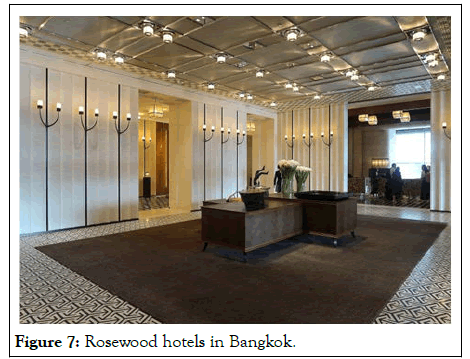
Figure 7: Rosewood hotels in Bangkok.
Hotel icon in Hong Kong cleverly utilizes the design of flower beds to avoid having the hotel entrance directly facing the driveway. This design ensures that the internal road leading to the hotel does not exceed the flower bed area between the twoway lanes opposite the hotel. It follows the Feng Shui principle of avoiding a direct line of sight that passes straight through. Additionally, the seating design in the green bar makes clever use of semi-circular arrangements, narrow passages, and a table at the far end to enclose the entrance, allowing the financial luck to remain within the spacious void above.
In the design of Banyan tree hotel in Bangkok, careful consideration is given to the layout of guest entrances, walkways, and sightlines. The positioning of the swimming pool takes advantage of the gaps between the surrounding high-rise buildings, ensuring better air circulation and providing an expansive view (Figure 8).
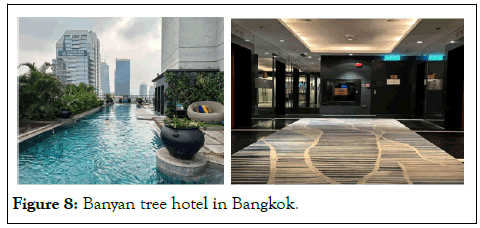
Figure 8: Banyan tree hotel in Bangkok.
Numerical preferences: Different countries have preferences or taboos regarding certain numbers, and this is widely reflected in Asian hotels. For example, the hotel icon in Hong Kong avoids the numbers "13," "14," and "24" in the arrangement of floor buttons in the elevator. This is because the hotel's architectural design does not include floors 3 to 8. However, the height of the 2nd floor is actually much higher than two floors, but it is labeled as the 2nd floor due to the sequence and functional reasons. At the entrance of Sukhothai hotel in Bangkok, there are 9 Buddha altars, as the number 9 is considered auspicious in Thailand (Figures 9 and 10).
Figure 9: Hotel Icon in Hong Kong.
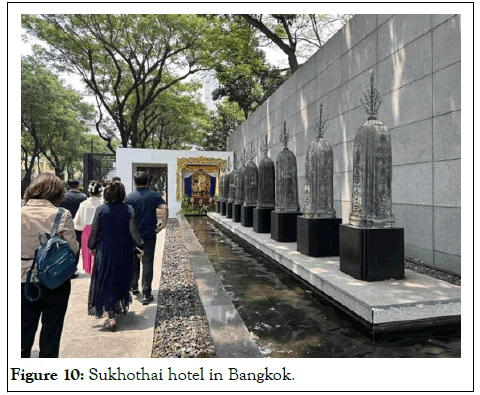
Figure 10: Sukhothai hotel in Bangkok.
Room orientation: In hotels, the orientation of guest rooms is chosen to avoid cemeteries, sources of pollution, and toilets. Additionally, rooms are selected to have ample sunlight and good ventilation. According to Feng Shui, the orientation of a room can influence the fortune of its occupants. Passageways commonly used by guests are designed to avoid direct alignment between doors. As shown in the image, the room doors in the upper right corner of the hotel icon in Hong Kong are positioned with a displacement of the door frames to minimize this issue (Figure 11) [24].
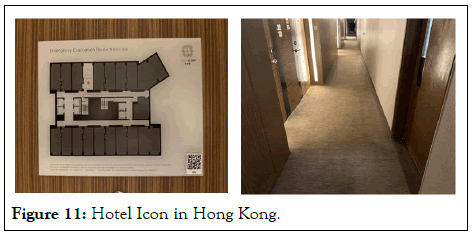
Figure 11: Hotel Icon in Hong Kong.
Interior decoration: In the lobby of Rosewood Hong Kong, there is a central foyer table with four corners. Each corner is adorned with a yacht model, books, flowers, and an upright picture frame. Additionally, there is a simulated veranda that brings a sense of natural dialogue to the enclosed indoor setting. Furthermore, on the bedside table, there is a shelf displaying a local oil painting album from Hong Kong. The original artwork of one of the paintings is conveniently showcased above the mini-bar, creating a harmonious blend of reality and illusion (Figure 12).
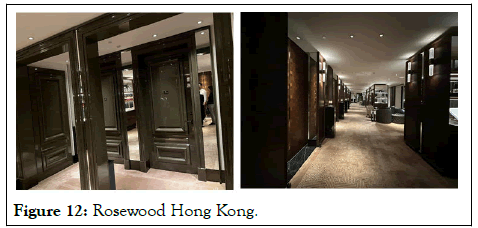
Figure 12: Rosewood Hong Kong.
In the rooms of the hotel icon in Hong Kong, the rounded design of the corner at the end of the hallway not only provides a visually pleasing and comfortable sense of security but also creates an illusion of a larger space within the room (Figure 13).
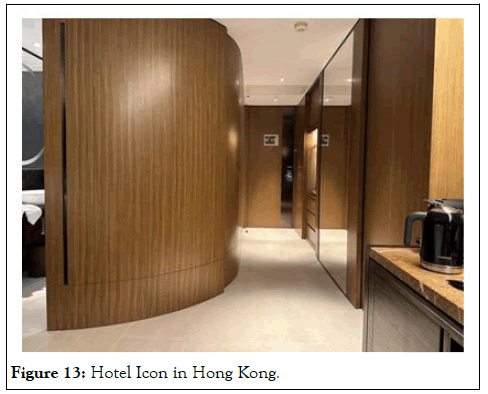
Figure 13: Hotel Icon in Hong Kong.
Bathroom design: According to Feng Shui beliefs, the positioning of the bathroom can affect the overall energy flow of the room. In Asian hotels, it is common to see bathrooms positioned to avoid directly facing the bed or the entrance. They are also decorated with corresponding Feng Shui symbols or items to prevent financial loss. The toilet arrangement, especially in the hotel Icon in Hong Kong, is particularly emphasized. Within the limited space of the restroom, the use of curved glass in the shower area adds a sense of design and maximizes space efficiency compared to a square design. Similarly, at Mandarin oriental in Bangkok, the glass partition between the toilet, bathtub, and washbasin not only saves on partition thickness but also avoids the Feng Shui taboo of the toilet directly facing the head of the bed (Figures 14 and 15).
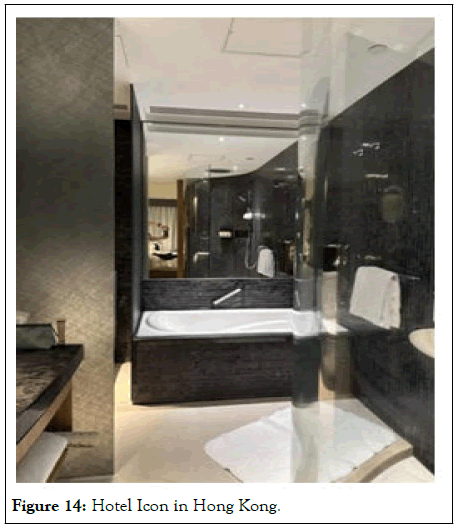
Figure 14: Hotel Icon in Hong Kong.
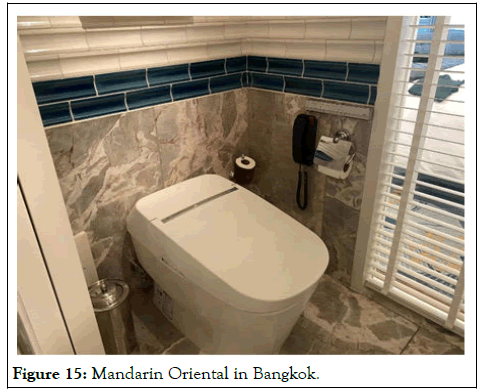
Figure 15: Mandarin Oriental in Bangkok.
Color coordination: In Feng Shui culture, colors are closely related to the five elements, and each color represents different elements and characteristics. The selection and combination of colors in Asian hotel designs are highly considered. For example, red represents the fire element, so it is commonly used in hotel restaurants and bars to create a sense of passion and romance. Additionally, Feng Shui believes that colors can influence the energy field, and some designs reflect the principles of the five elements' generation and restraint through color selection. For instance, green represents the wood element, while red represents the fire element. It is important for colors to align with the hotel's theme and brand image. For example, the Oriental Mandarin hotel in Thailand often adopts warm color tones, creating a sense of closeness, warmth, and tranquility for its guests.
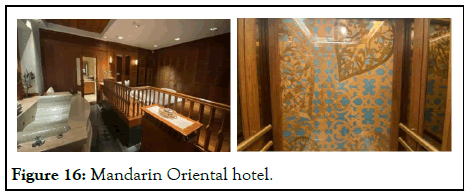
Figure 16: Mandarin Oriental hotel.
Material selection: In Feng Shui culture, various materials also represent different elements and characteristics. For example, metal represents the metal element, while wood represents the wood element. Hotels often utilize metal materials in the decoration of their lobbies, restaurants, and other areas to enhance a sense of nobility and grandeur. Feng Shui culture encourages the use of the five elements (metal, wood, water, fire, and earth) to balance the energy in the space. The Banyan tree Bangkok hotel and Sukhothai hotel Bangkok both extensively incorporate colors and materials that correspond to the five elements. For instance, they utilize Thai silk, wooden furniture, metal decorations, and water features, which align with the principles of the five elements. Similarly, The Rosewood Bangkok combines wood and metal materials to create an auspicious and harmonious atmosphere, balancing the energy in the space.
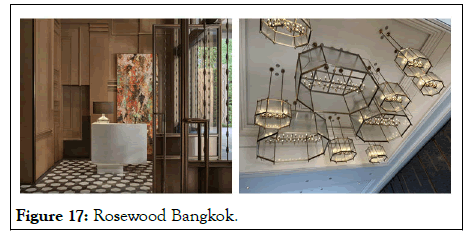
Figure 17: Rosewood Bangkok.
Symbolic graphics: In Feng Shui symbolism, squares represent order and structure, serving as the foundation of one's character, while circles represent harmony and maturity, reflecting the way of living. Without squares, the world lacks rules and constraints, while without circles; the world carries excessive burdens and becomes unmanageable. When interacting with others and navigating through life, one should embrace both squareness and roundness, adapting accordingly. The integration of squares and circles symbolizes the harmony between heaven and earth.
The decorations, layout, and furniture of the Banyan tree Bangkok hotel reflect the symbolism of squareness and roundness. For example, in the bathrooms, there are round wash basins that correspond to square dressing tables. In the bedrooms, you can find round decorative doors that match square background panels. This use of square and round elements throughout the hotel's design represents the concept of balance and harmony between these two shapes, creating a visually pleasing and harmonious atmosphere for guests (Figure 18).
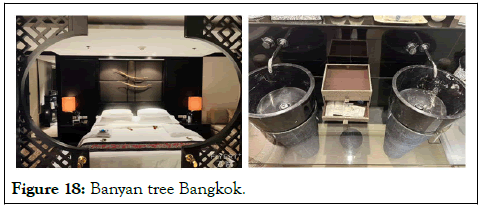
Figure 18: Banyan tree Bangkok.
In the Rosewood Hong Kong and Rosewood Bangkok, the bagua diagram represents different elements and symbols, and their combinations and variations are believed to explain the generation, transformation, and extinction of all things. In the Green restaurant of hotel icon, the opposite wall of the green plant wall is the outer wall of the elevator shaft. The decorative strokes of Chinese characters not only beautify the wall but also highlight the hotel's connection to the Chinese character region in Asia. The artwork is called "The Dao gives birth to one, one gives birth to two, two gives birth to three, and three gives birth to all things." Its creator, Hong Qiang, attempts to express the concept of the life cycle of humanity and all things in the world, as well as their interrelation with the trajectory of the universe, through traditional Chinese scroll art and the use of blank space (Figures 19 and 20).
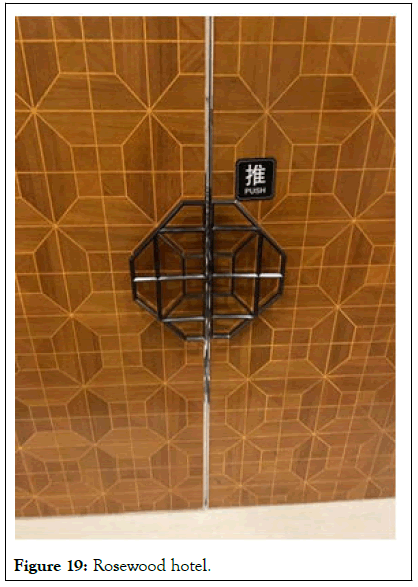
Figure 19: Rosewood hotel.
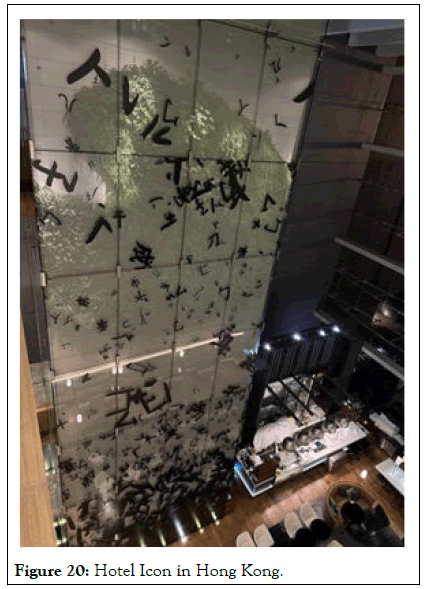
Figure 20: Hotel Icon in Hong Kong.
Lighting and ventilation: In Feng Shui culture, the flow and distribution of light are also highly important as they can influence the energy flow within a space. Asian hotels often have sufficient windows and open spaces in their guest rooms and public areas to ensure ample sunlight enters the hotel while avoiding harsh light and shadows. The lighting design at Banyan tree hotel in Bangkok takes into consideration the arrangement of light, creating a more balanced and natural distribution and flow of light while avoiding the interplay of strong light and shadows (Figure 21).
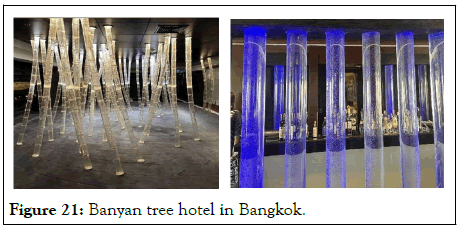
Figure 21: Banyan tree hotel in Bangkok.
The guest rooms and public areas of The Rosewood Hong Kong are equipped with ample windows and open spaces to ensure sufficient sunlight and fresh air, which aligns with the Feng Shui principles of natural light and good ventilation. Additionally, the bedside reading lamps in these hotels are designed with offset lighting to avoid harsh glare and enhance light diffraction, providing a greater sense of comfort (Figure 22).
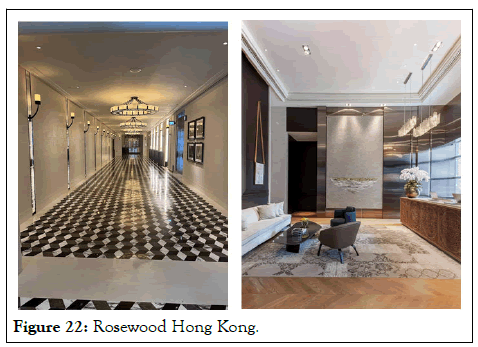
Figure 22: Rosewood Hong Kong.
Animal symbolism: Elephants are considered auspicious symbols, and the image of bats is widely used in the interior design of the Rosewood hotels, symbolizing good luck. In Chinese culture, peacocks are regarded as beautiful, noble, and auspicious birds, representing virtues, glory, and nobility. They are often used to decorate royal buildings and objects to showcase the authority and status of the emperor (Figure 23).
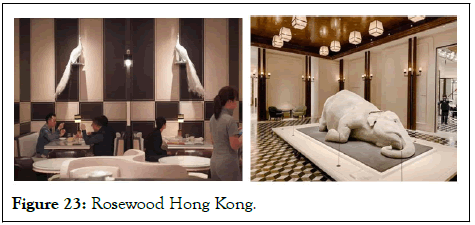
Figure 23: Rosewood Hong Kong.
Plant applications: The design of the green plant wall in the lobby of the hotel icon in Hong Kong starts from the check-in counter background, extends across the ballroom floor, and connects with the background wall of the green restaurant in the lobby. It is a major highlight of the hotel's design, where the large open space and extensive greenery create a tranquil and comfortable atmosphere in the urban setting. Similarly, the abundance of lotus ponds in the gardens of the Sukhothai hotel in Bangkok is also a proud and distinctive feature of the hotel (Figures 24 and 25).
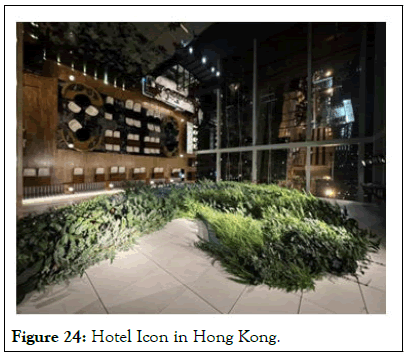
Figure 24: Hotel Icon in Hong Kong.
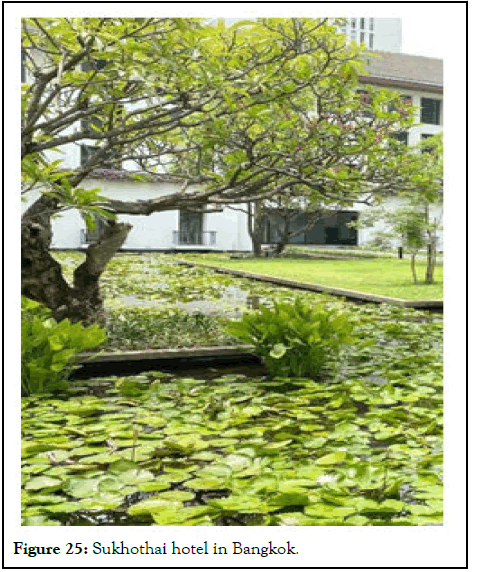
Figure 25: Sukhothai hotel in Bangkok.
Artwork and decorations: Hotels choose meaningful artwork and decorations that can enhance the ambiance and auspiciousness of the space. In Feng Shui, it is believed that a city, a village, a courtyard, a building, a residence, a room all represent a Tai Chi, just at different levels. The decorations inside the rooms of the Banyan tree hotel in Bangkok, including the design of doors and windows, feature many Tai Chi patterns, reflecting the concept of balancing Yin and Yang and achieving energy equilibrium in Feng Shui (Figure 26).
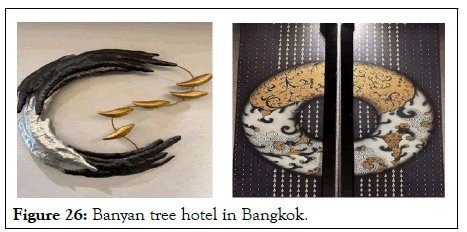
Figure 26: Banyan tree hotel in Bangkok.
Therefore, this study has summarized a total of 16 open-ended codes, namely location, architectural design, entrance, environmental arrangement, space layout, numerical preferences, room orientation, interior decoration, bathroom design, color coordination, material selection, symbolic graphics, lighting and ventilation, animal symbolism, plant application, and artwork and decorations.
Encoding basis
Before conducting principal axis encoding and selective encoding, it is necessary to clarify the direction of encoding for further analysis. Therefore, it is important to review existing literature and identify the basis for encoding.
Feng Shui is an ancient Chinese philosophy that emphasizes the relationship between the environment and individuals, believing that the environment has a profound impact on people's lives and careers. In Asian culture, Feng Shui is widely applied in architecture and interior design, especially in the hotel and residential fields.
Throughout history, many phenomena cannot be explained by scientific means, leading people to engage in psychological suggestion and promotion. It is widely believed that a favorable Feng Shui environment can bring good luck and prosperity, while negative Feng Shui can bring misfortune and adversity. Ancient Chinese architecture, for instance, evolved from such psychological development. Therefore, in hotel design, Feng Shui is considered an important element to ensure that guests can rest and relax in a favorable environment, and it can also have positive psychological effects on the smooth operation of the hotel.
Furthermore, Feng Shui reflects people's pursuit of balance and harmony. It emphasizes the interaction between individuals and the natural environment, suggesting that only when the two achieve balance and harmony can people attain success and happiness. Therefore, in hotel design, Feng Shui is regarded as a factor for achieving balance and harmony, ensuring that guests can spend their time in a comfortable, peaceful, and harmonious environment.
Feng Shui theory is deeply influenced by the philosophical concepts of the "Book of Changes". It is said that during the Jin Dynasty, Guo Pu wrote in his work "Burial Book": "Burial is about harnessing the vitality. When the Qi rides the wind, it disperses; when it encounters boundaries like water, it stops.
The ancients gathered it to prevent dispersal, and directed it to create stops. Therefore, it is called Feng Shui. The principles of Feng Shui prioritize water and include the influence of wind." From this, it can be understood that Feng Shui involves both the aspects of "Qi" and "form". Through long-term academic discussions and developments, two major theoretical branches of Feng Shui have emerged: The school of Qi (Li Qi Pai) and the school of form.
The school of Qi primarily focuses on the study of Yin and Yang, the five elements, the eight trigrams, and the heavenly stems and earthly branches, which are important theoretical systems in ancient Chinese philosophy. Yin and Yang refer to two opposing but interdependent forces in the universe, while the five elements represent the five fundamental elements in the universe: Metal, wood, water, fire, and earth. In Feng Shui culture, Yin and Yang and the five elements are widely applied in the study of the environment, architecture, and human destiny.
The school of form involves the study of five important elements: Qi, wind-water, four symbols, form, and orientation. So far, scholars both domestically and internationally have not reached a universally satisfactory conclusion regarding the concept of "Qi". However, a relatively authoritative modern physics perspective suggests that the essence of "Qi" is subatomic particles and their fields. This theory bears some similarity to the ancient Chinese understanding of "formation when gathered and dissipation when dispersed". The "Burial Book" asserts that the accumulation of "vital Qi" must occur in an ideal location, where the Qi disperses with the wind and stops at boundaries formed by water. This implies the reliance on two primary conditions: Concealing the wind and gathering the water, as the combination of hidden wind and gathered water brings vitality.
The theory of four symbols originates from the historical development of Chinese astronomy's 28 constellations irregularly composed of asterisms. The sky is divided into these 28 asterisms, which are further grouped into four symbols. Each symbol consists of seven asterisms, and they are divided based on their shapes and directions in the sky: The azure dragon in the East, the vermilion bird in the South, the white tiger in the West, and the black tortoise in the North. The dragon and tiger are also important core concepts in Feng Shui culture. The dragon is a mythical creature in traditional Chinese culture, symbolizing power, nobility, and good fortune, while the tiger symbolizes bravery, strength, and dignity. In Feng Shui culture, the dragon and tiger are often used to study the energetic field of the environment and architecture, and there is a saying "left azure dragon, right white tiger, front vermilion bird, back black tortoise".
Yang Junsong, during the Tang dynasty (618-907), developed a comprehensive analysis method for the Xingshi school, which is based on the understanding of landscapes, including the contours of the terrain, the flow of rivers, and geographic structures. He focused on the shape of mountains, mountain ranges, the direction of rivers, and the relationship between mountains and water. Yang Junsong's analysis emphasized five geographical factors: Longmai (dragon veins), Sha (sand), Shui (water), Xue (caves), and Fangwei (directions). By combining these five geographical factors with the principles of Qi, Feng- Shui, the four symbols, and situations, he established a systematic analysis method for the Xingshi school. This method has evolved into what we commonly refer to as Feng Shui layout, which is widely applied in various fields such as residential, commercial, and public spaces to adjust the energy field and improve human destiny and well-being. In the context of Feng Shui culture, the core categories can be summarized as Yin and Yang, the five elements, the eight trigrams, the four symbols, situations, and directions. In this study, we will specifically examine five hotels in Bangkok and Hong Kong based on these six categories.
Axial coding
Based on the aforementioned categories and open coding, this study further classified them into the following axial codes:
"Seeking harmony and responding in unison": This phrase signifies the importance of working together and pursuing common goals. It emphasizes the need for emotional alignment and resonance among individuals when striving for shared objectives. Only through mutual support and encouragement can collective motivation and confidence be stimulated. Particularly in Chinese culture, there is an emphasis on the relationship between the individual and the collective, believing that only when each person considers the interests of the collective can common goals and benefits be achieved. Therefore, Asian hotels embody the traits of mutual assistance, unity, cooperation, and win-win outcomes.
Water as wealth: Asian hotels often use water and greenery for decoration, which corresponds to a fundamental principle in Feng Shui: "Mountains govern people, and water governs wealth." This is because water is related to wealth. In places that attach importance to Feng Shui, such as Huizhou architecture, the eaves are inclined towards the interior to allow rainwater to flow into the house, symbolizing the belief that "fertile water should not flow into someone else's field." Water not only embellishes the external environment of hotels but also represents circulation. By engaging in more communication with people and exploring the world, one's fortune naturally improves, as symbolized by the expression "letting the water find its own course."
Frugality: Many Asian hotels practice ecological conservation and sustainable development. For example, they consider energy efficiency and environmental friendliness when selecting decorative materials. Additionally, they reduce environmental pollution by choosing eco-friendly materials for guest rooms. These practices reflect the values of frugality, cherishing resources, rational utilization, and environmental consciousness in traditional Asian culture. This value system emphasizes the rational use of resources, environmental protection, and the harmony between individuals and collectives, individuals and nature, and interpersonal relationships.
Extremely inauspicious: In the study of Feng Shui, examples of extremely inauspicious dwellings are often characterized by unconventional and irregular shapes, with uneven corners in the house. This concept originates from the "Book of Changes", where any extreme and drastic changes in hexagrams are considered dangerous. In contrast, Asian hotels tend to exhibit curved and symmetrical designs, and they emphasize maintaining a balanced relationship with their customers, providing a welcoming and hospitable experience. This reflects the Asian value of avoiding extremes and allowing room for flexibility in life.
Not bullying others: The design of Asian hotels reflects the respect for the guests' personality, dignity, and privacy. This is because Asians have always emphasized interpersonal relationships and social order, highlighting equality and respect among individuals. Only on the basis of equality can harmonious social and interpersonal relationships be established, which also reflects the values of respect, humility, etiquette, and human care in Asian traditional culture. Additionally, "not bullying others" also reflects traditional virtues such as benevolence, loyalty, courage, and honesty.
Harmonizing with the environment: The architectural designs of Asian hotels often adhere to local environmental and planning requirements. This demonstrates a pragmatist worldview that emphasizes making the most appropriate decisions and taking action based on the current situation and environment, rather than rigidly adhering to fixed principles or beliefs. Furthermore, Asian hotels emphasize practicality and efficiency, striving to make optimal decisions and take actions within the shortest possible time. This reflects the values of adaptability, flexibility, and innovation, as it requires people to quickly adapt to changing environments and adopt the best course of action.
Selective coding: Based on axial coding, the following five selective codes are derived.
Respect for the natural environment: Asian hotels typically adhere to the principles of Feng Shui in their architectural design and decoration to create a harmonious atmosphere with the natural environment. For example, factors such as natural light, wind direction, and water flow are taken into consideration in the layout and decoration of the hotel to create a comfortable and health-promoting environment. The distinctive architecture of Rosewood Bangkok and the lotus canal at Sukhothai hotel in Bangkok exemplify the reverence for the natural environment.
Respect for traditional culture: Asian hotels often incorporate traditional cultural elements in their design and services to showcase the local cultural characteristics and historical heritage. Traditional building materials and handicrafts are used in the architecture and decoration of the hotel. The octagonal and bat motifs in Rosewood hotel, the Thai silk wallpaper and the nine Buddha altars at the entrance of Sukhothai hotel, all demonstrate respect for traditional culture.
Emphasis on harmony and balance: Asian hotels typically prioritize the harmony and balance of the hotel environment. Sharp angles and straight lines are avoided in the layout and decoration of the hotel, and instead, soft curves and arcs are used to create a more harmonious environment. Examples include the design of washroom facades in the hotel Icon in Hong Kong and the decorative elements of Yin-Yang balance and Tai Chi in Banyan tree Bangkok, all embodying the emphasis on harmony and balance.
Respect for guest needs: Asian hotels typically focus on meeting the needs and experiences of guests by providing personalized services and customized experiences. Attention is paid to guest privacy, safety, and offering personalized choices in hotel services.
Emphasis on destiny: Asian hotels usually value the influence of destiny and fortune in creating an environment that is conducive to the success and well-being of guests. In the layout and decoration of the hotel, inauspicious symbols and colors are avoided, and instead, auspicious colors and elements are used to enhance the fortune and luck of guests. Examples include the lighting ceremony and decorative items representing yin-yang balance at Banyan tree Bangkok, as well as the peacock, bat, and octagonal motifs at Rosewood Hong Kong, and the elevator numbers at hotel icon in Hong Kong. All of these exemplify the emphasis on destiny (Table 1).
| Open coding | Axial coding | Selective coding |
|---|---|---|
| Location | Seeking harmony and responding in unison | Respect for the natural environment |
| Architectural design | ||
| Entrance | Water as wealth | |
| Environmental arrangement | ||
| Space layout | Harmonizing with the environment | Respect for guest needs |
| Numerical preferences | ||
| Room orientation | ||
| Interior decoration | Frugality | Respect for traditional culture |
| Bathroom design | ||
| Color coordination | ||
| Material selection | Extremely inauspicious | Emphasis on harmony and balance |
| Symbolic graphics | ||
| Lighting and ventilation | ||
| Animal symbolism | Not bullying others | Emphasis on destiny |
| Plant application | ||
| Artwork and decorations |
Table 1: Coding process.
The design, architecture, and decoration of Asian hotel paradigms fully incorporate the principles of Feng Shui culture, showcasing the concept of harmonious coexistence with nature through the form, colors, materials, and decorations of the hotel buildings. The architecture of the hotels takes into account factors such as natural light, ventilation, and natural elements to allow guests to experience a sense of nature even indoors. The decorations also consider the symbolic meaning of Feng Shui culture, using elements such as stone and water features to create a natural and comfortable ambiance. The contemporary Feng Shui culture's ideas of "advocating nature" and "unity of heaven and humanity" have important influences on regulating human moral behavior, coordinating the relationship between humans and nature, and establishing a holistic ecological view that emphasizes the importance of humans, nature, and society. Moral ethics is one of the important contents in Feng Shui culture, and it is regarded as an important guarantee for human destiny and happiness. It emphasizes that humans should respect nature, respect others, respect tradition, and pursue a harmonious, balanced, and beautiful life. Therefore, by observing the manifestation of Feng Shui culture in hotels, we can summarize the values of the Asian hotel paradigm as "respecting the natural environment, respecting traditional culture, emphasizing harmony and balance, respecting guest needs, and valuing fate." These values align with the moral ethics of society and reflect the cultural values and behavioral guidelines of Asian hotels. The application of Feng Shui culture in Asian hotels not only embodies the cultural heritage of Asian traditional culture but also makes the hotels more in line with human needs and the requirements of the natural environment. Through the application of Feng Shui culture, the principles of symbolism and implication are aesthetically packaged through the presentation of the hotels, utilizing the aesthetics of life and the essence of moral culture. Asian hotels integrate the scientific proposition of the unity of heaven, earth, and humanity into human centered design, reflecting the humanistic care of hotels and providing guests with a more comfortable and harmonious accommodation experience.
Although the observational method is straightforward and simple, there are also some limitations. For example, there may be observation biases, and the results may be influenced by subjective factors of the observers. Therefore, it is important to be aware of these issues when using the observational method and take corresponding measures to reduce biases and errors. In this study, multiple interpretations and cross-comparisons of the results were conducted by the members to ensure the objectivity of the observational findings.
Furthermore, there is debate over whether Hong Kong and Bangkok can represent Asian culture and whether Asian culture exists within a common framework. It may be necessary to further expand the regional scope of empirical research in future studies to ensure the broad applicability of these conclusions. Additionally, before the widespread dissemination and application of Feng Shui theory, it is necessary to establish a theoretical conceptual model for the application of Feng Shui. By utilizing relevant knowledge and existing techniques, a structured theoretical framework for Feng Shui could be established, which may help enhance the application of Feng Shui. Therefore, it is possible to expand the development of scales or conduct quantitative research to ensure the reliability and validity of the model.
Citation: Zhang H (2023) A Study on the Cultural Values of Asian Hotels from the Perspective of Feng Shui. J Tourism Hospit. 12:540.
Received: 18-May-2023, Manuscript No. JTH-23-24240; Editor assigned: 22-May-2023, Pre QC No. JTH-23-24240 (PQ); Reviewed: 05-Jun-2023, QC No. JTH-23-24240; Revised: 19-Dec-2023, Manuscript No. JTH-23-24240 (R); Published: 26-Dec-2023 , DOI: 10.35248/2167-0269.23.12.540
Copyright: © 2023 Zhang H. This is an open-access article distributed under the terms of the Creative Commons Attribution License, which permits unrestricted use, distribution, and reproduction in any medium, provided the original author and source are credited.